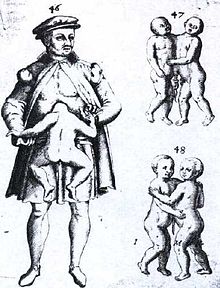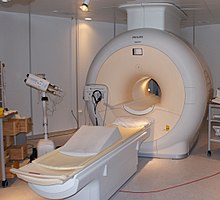User:Ewaki/sandbox
Abstract
[edit]
A vestigial twin is a form of parasitic twinning,[1] where the parasitic "twin" is so malformed and incomplete that it typically consists entirely of extra limbs or organs. It also can be a complete living being trapped inside the host person, however the parasitic twin is anencephalic and lacks consciousness.
This phenomenon occurs when a fertilized ovum or partially formed embryo splits incompletely. The result, one dominant twin with extra body parts belonging to the vestigial twin. It is also possible for tail-like tissue to form around the sacrum.[2]
Most vestigial limbs are non-functional, and although they may have bones, muscles and nerve endings, they are not under the control of the host. The possession of six or more digits on the hands and feet (polydactyly) usually has a genetic or chromosomal cause, and is not a case of vestigial twinning.
Signs and Symptoms
[edit]Woman that are pregnant do not have any different symptoms carrying vestigial twins than with a normal pregnancy. A prenatal ultrasound can be done to detect and diagnose a vestigial pregnancy before birth. There have been times where an ultrasound was unable to show the pregnancy was vestigial twins. The patients physician can order follow up MRI or CT scan to further evaluate the pregnancy. An echocardiogram may also be done to further inspect the fetus in the womb and see if the dominant twins heart is being strained.[1]
Once the fetus is born the presentation will consist of an extra extremity attached. Unlike other cases of conjoined twins, vestigial twins will consist of an entire extra limb not just for example a thumb. The second fetus is not viable and will not survive. Only the dominant fetus will be viable with extra attached limbs. The limbs attached will contain nerve endings, bones, and tissue. In some cases the fetus can be born with a attached limb as a "tail." This tail is the extension of the coccygeal vertebra.[2]. The host fetus will not have any control over the extra limbs. The parasitic twins limbs can be attached to the dominant twin at more than one location for example the head, torso, pelvis, buttocks, back, etc. [3]
Cause
[edit]
The cause for vestigial twins is still unclear. Researchers have two theories that they believe causes this phenomenon: fission theory and fusion theory. Fission theory is when two fetuses are in the womb and one of the conjoined twins stops developing.[1] The fusion theory proposes that there are two separate fertilized eggs in the womb, however they fertilized eggs end up growing together. [1]
Another potential cause researchers are investigating an abnormalities in SHH proteins. SHH, sonic hedgehog protein, plays an important role in development of cells. Researchers believe that potential abnormalities in this protein can put woman at higher risk for potentially having parasitic pregnancies. [3]
There is no way to prevent this from occurring. This disease is not contagious and occurs rarely in pregnancies. There are currently no CDC recommendations on this, as this is a rare occurrence.
Mechanism
[edit]This disease impacts pregnant women expecting twins. It is unknown why these twins do not separate, however once the fetus is born the parasitic twin is attached. Possible theories include abnormalities in SHH proteins. SHH protein is vital in cell development, researchers believe this can cause the twins to be conjoined and then one stops developing. This then leads for the fetus to be born with a parasitic twin attached. Fission theory is another theory researchers believe this occurs. Fission theory would indicate the two fetuses in the womb began as conjoined twins and the parasitic twin stopped developing, leading to vestigial twins being born.[1] The last theory researcher believe can potentially cause vestigial twins is fusion theory. According to the fusion theory there are two fertilized eggs in the womb that end up fusing together, this would create a fetus with the parasitic twins limbs attached. [1] The dominant twin is impacted because the parasitic is somehow attached to their body. The parasitic twin can be attached at the head, torso, buttocks, back, etc. Vestigial twins occurs very rarely so it is unknown why the dominant twin is born with the parasitic twins limbs attached.
Diagnosis
[edit]
Early diagnosis can be found during a prenatal ultrasound. A prenatal ultrasound uses sound waves to show the fetus in the womb.[4] However, there have been some cases that it was not possible to diagnose the vestigial twin before birth using an ultrasound. There is no way to prevent vestigial twins or diagnose vestigial twins through pregnancy symptoms.Vestigial twins can be diagnosed before birth through an ultrasound or other imaging such as MRI or Ct scan. An MRI or CT scan can show how the twins are connected, After birth the diagnoses can be made by looking at the parasitic twin attached to the vestigial twin. An obstetric and gynecology physician can be treat and diagnose this patient, however the pregnant women may be referred to a maternal and fetal medicine specialist. There may be different surgeons assigned to the case to assist with removing the parasitic twin.[5] There may be a delay in diagnoses if the pregnant women does not seek prenatal treatment or schedule any ultrasounds. At times it may be difficult to visualize the parasitic twins on an ultrasound which would cause a delay in diagnoses until birth. However, once the vestigial twins are born it would be easily diagnosed during a physical exam.
Treatment
[edit]Treatment for vestigial twins typically includes having surgery to remove the parasitic twin. If the parasitic twin is not removed it can lead to further complications. The twin supporting the parasitic twin can have complications. Therefore, the best course of treatment would be to remove the attached parasitic twin. A healthcare provider can then run tests to check to see if the fetus has any complications and treat them. Treatment for other complications would be different based on each case. [1]
After the fetus undergoes the procedure to remove the parasitic twin there is a risk to developing infection, hernia, and typical surgical complications.[1] There are no holistic treatment options other then leaving the parasitic twin attached, however leaving the parasitic twin attached to the dominant twin can lead to further complications for the dominant twin. The dominant twins body can be put under a lot of stress if still attached to the parasitic twin. Surgery to remove the parasitic twin is the only treatment to remove the parasitic twin from the dominant twin.
Prognosis
[edit]The parasitic twin should be removed from the host twin, once the surgery is done there is no reoccurrence of the twin growing back. The surgery is typically done right after birth. The fetus then will be able to develop and have a normal life expectancy. The typical prognosis for the case studies that have been found is overall good once the parasitic twin is seperated. If the host twin has some complications such as a hernia and or infection more treatment may be needed. The occurrence does not repeat after the parasitic twin is removed.
It is unclear if there is an environmental or hereditary risk factor associated with vestigial twins. However, researchers believe that abnormalities in the SHH protein can create a risk or a possible explanation for having vestigial twins.
Epidemiology
[edit]Vestigial twins is a rare occurrence, it has been reported that it occurs less than 1 in 1 million births. [6] Woman of child bearing ages that are pregnant with twins can be impacted. Twin fetuses that are still developing in the womb can become vestigial twins, although this is a rare occurrence. Since this occurrence is so sparse it is unclear whether it impacts different ethnicities or races. However, rachipagus parasiticus, an extremely rare type of parasitic twins, is most commonly reported in Ethiopia. Rachipagus parasiticus is where the parasitic twin is attached to the spine.
Research Directions
[edit]There are currently no clinical trials or research trials available for vestigial parasitic twins. Since this is such a rare occurrence there is not enough patients or known to develop any drug treatments. It is unclear if any medications can be used to prevent or treat vestigial parasitic twins, however surgery to separate the twins has been found to be a success in the cases that do occur. There are no current drug trials to treat this. Surgery to remove the extra cells leads to a good outcome.
References
[edit]- ^ a b c d e f g "Parasitic Twin". Cleveland Clinic.
{{cite web}}: CS1 maint: url-status (link) - ^ "Tail-like Congenital Duplication of Lower Extremity (Extra Leg or Vestigial Parasitic Twin)".
- ^ a b Selemin, Julian. "What Are Parasitic Twins?". WebMD. Retrieved 2024-11-02.
- ^ Contributors, WebMD Editorial. "What You Need to Know About the Prenatal Ultrasound". WebMD. Retrieved 2024-11-05.
{{cite web}}:|last=has generic name (help) - ^ "Conjoined twins - Diagnosis and treatment - Mayo Clinic". www.mayoclinic.org. Retrieved 2024-11-05.
- ^ Dejene, Belachew; Negash, Samuel A.; Mammo, Tihitena Negussie; Tadesse, Amezene; Getachew, Hanna; Derbew, Miliard (2018-10-01). "Heteropagus (parasitic) twins". Journal of Pediatric Surgery Case Reports. 37: 44–49. doi:10.1016/j.epsc.2018.07.019. ISSN 2213-5766.

